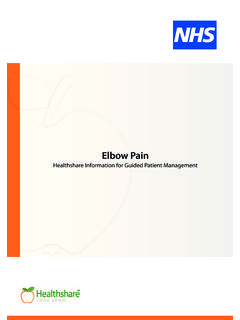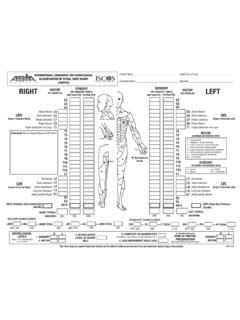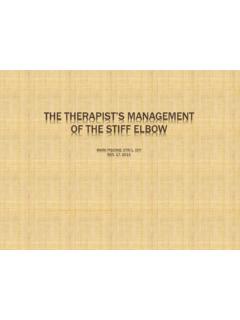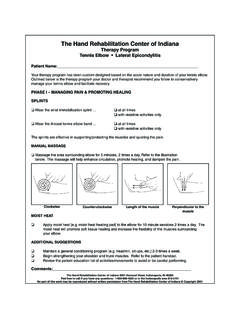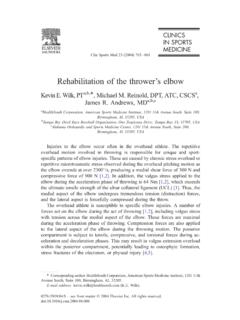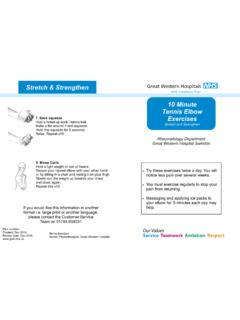Transcription of Elbow Rehabilitation Protocol Dislocations
1 1 Elbow dislocation Rehabilitation Protocol Elbow dislocation The Elbow Joint is the most complex joint in the body. In order for it to recover to its best function consistent Rehabilitation is essential in order to obtain the optimal outcome after injury. It is important that this be carefully carried out under the supervision of a therapist. Injuries to the Elbow can be very painful and this can cause difficulties with completing the required exercises. Before embarking on Rehabilitation program be sure that your therapist is aware of the nature and extent of the injury. Each Elbow needs specific Rehabilitation based on the injury type and nature of surgery performed.
2 Swelling Swelling is often a problem after Elbow injury. To minimise the effect of the swelling the Elbow should be elevated above heart level whenever possible. During the initial 1-2 weeks when asleep and awake the Elbow should be supported on pillows to achieve this. Ice may be applied several times a day for 20 mins and is an excellent pain-relieving agent. Pain Relief Dislocations , which are suitable after operation, should start Rehabilitation at 2. weeks unless otherwise directed. From 2-4 weeks pain medication should be taken regularly as prescribed. Not waiting for pain to be present will allow movement of the Elbow to begin helping to minimising stiffness.
3 It is best to do exercises on a frequent basis through the day. Multiple sessions of short duration are better than longer sessions done only once or twice. Ben East, 1 Summarised from: Techniques in Hand & Upper Extremity Surgery _ Volume 15, Number 4, December 2011 2 Splinting For injuries requiring splinting the device should pass both the Elbow and the wrist. It should be applied day 2-5 and kept on 24 hours a day, except for during range of motion exercises. The position should be in 80-90 deg of flexion to maximize stability and capsular volume. This needs to be easily removable to allow for ROM exercises. Positioning of forearm rotation is dependent on the operative findings and surgery please ask you surgeon about this or see the end of this document for guidelines.
4 Drop Sign Radiological objective measure demonstrating an increased ulno-humeral distance. This indicates that the anterior capsule has been avulsed. Static Ben East, 2 Summarised from: Techniques in Hand & Upper Extremity Surgery _ Volume 15, Number 4, December 2011 3 isometric exercises of the biceps, triceps and brachialis while resting in the splint should be conducted if a drop sign is present. This reduces the chance of gravitational stress stretching repairs, or recurrent subluxation from occurring in the splint. These should begin day 1 post-op. Shoulder abduction, or movement of the shoulder away from the body should be avoided for the first 4 weeks.
5 This is due to the stress that this movement puts on the Elbow reconstruction due to weight of the forearm. Excessive rotation of the forearm through the shoulder joint should also be avoided due to the stress this puts on the Elbow joint. Gentle passive shoulder pendular exercises out of the sling should be encouraged with the forearm supported by the other arm. Range of motion exercises of the wrist should also be encouraged if there is no damage to the flexor or extensor origins. Sleeping This should be done on your back with the Elbow supported on either side by a pillow facing the ceiling. Range of Motion Exercises Generally these should commence around day 7-10 for a terrible triad or Elbow dislocation unless otherwise specified in the operating report.
6 This may be done as below , or in a hinged range of motion brace or x-fix if applied. Free active assisted flexion, free extension to -30 deg off full extension, lying with shoulder 90 deg of abduction. It is best to do exercises on a regular basis through the day. Multiple sessions of short duration are better than longer sessions done only once a day. Ben East, 3 Summarised from: Techniques in Hand & Upper Extremity Surgery _ Volume 15, Number 4, December 2011 4 Active pronation and supination. Should be encouraged as this applies a force across the joint and helps maintain joint reduction. Avoid passive supination, shoulder abduction and excessive internal/external rotation for first 6 weeks.
7 Specific Structures and Rehabilitation Considerations o LCL Repaired and MCL intact orthosis at 80 deg. Forearm full pronation. Active extension of the Elbow in pronation until 6 weeks, limited to 30-45 deg off full extension. Active supination after more than 90 deg of flexion gained. o LCL intact MCL injured neutral rotation, or supination. Active extension avoided past last 30 deg for the first three weeks, or as specified in the post-operative instructions Active forearm rotation once 90 deg of flexion obtained. Avoid active shoulder abduction for 6 weeks. Ben East, 4 Summarised from: Techniques in Hand & Upper Extremity Surgery _ Volume 15, Number 4, December 2011 5 o MCL and LCL injured - neutral rotation.
8 Active extension avoided past last 30 deg for the first three weeks, or as specified in the post- operative instructions. Active forearm roation once 90 deg of flexion obtained. Avoid active shoulder abduction for 6 weeks. If questions about LCL also position in neutral o Anterior capsule with drop sign - Intermittent isometric exercises for biceps, triceps and brachialis in the splint to avoid redislocation. When ROM is commenced this should be in neutral rotation in an overhead, supine fashion to limit gravitational forces on the Elbow and varus/valgus stress. o Flexion Contracture: If this is developing early during the post- operative recovery it is best to discuss it with the treating surgeon and ask about the appropriateness of intervention.
9 Follow-up Weekly xray for 3 weeks for any patient with a complex dislocation that is, any Elbow which is not stable to within -30deg of extension, or any Elbow which required surgical reconstruction. Xray at anytime if a patient feels increasing pain and loss of range of motion. Remove splint week 6 and gradually stretch out anterior capsule by active and passive extension exercises. If using a range of motion brace then consider increasing the extension by 10. deg per week starting from week 4. Ben East, 5 Summarised from: Techniques in Hand & Upper Extremity Surgery _ Volume 15, Number 4, December 2011
